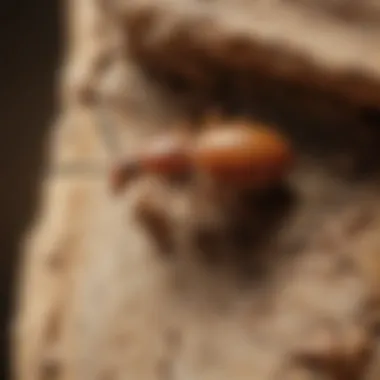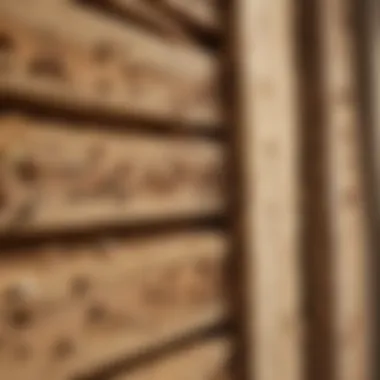Protecting Your House from Termites: A Comprehensive Guide


Intro
Termites are small insects that cause massive damage to homes and structures. They feed on wood, paper, and other cellulose materials, resulting in costly repairs for homeowners if not addressed quickly. This article aims to provide valuable insights on how to protect your home from termite attacks. By understanding their biology and behaviors, knowing the signs of an infestation, and implementing effective prevention and control strategies, you can safeguard your property effectively.
Understanding the Pest
Identification
Termites often resemble ants, but they can be distinguished by their straight, beaded antennae and broad waists. There are several species, including subterranean, drywood, and dampwood termites. Each type has a unique habitat preference and feeding habits. Subterranean termites, for example, nest underground, whereas drywood termites inhabit dry wood. Recognizing these differences is vital for proper management.
Life Cycle
Termites go through a complex life cycle, which includes four stages: egg, nymph, adult worker, and reproductive. The queen can lay thousands of eggs each day, leading to rapid population growth. Nymphs mature into adults and may take on roles within the colony, such as workers or soldiers. Understanding this life cycle helps in grasping why infestations can escalate quickly if left unchecked.
Pest Prevention Strategies
Environment Modification
To reduce the likelihood of termite infestations, it is important to modify the environment around your home. This includes:
- Reducing moisture: Termites thrive in damp conditions. Ensure gutters, downspouts, and drainage systems are functioning properly, directing water away from your foundation.
- Removing wood debris: Clear away piles of wood, dead trees, and stumps from your yard. These materials serve as a food source and nesting site for termites.
- Proper landscaping: Keep soil and mulch below the level of wood siding. This makes it difficult for termites to reach your home.
Physical Barriers
Installing physical barriers is an effective way to prevent termites from accessing your home. This may include:
- Steel mesh: Place this mesh around foundations to block termites.
- Concrete barriers: Concrete is impenetrable to termites and can be poured at key locations, such as around foundations and in crawl spaces.
Control Methods
Chemical Control
Chemical treatments provide effective options for managing termite infestations. Professional pest control services often use insecticides to create barriers and treat existing colonies. Commonly used chemicals include fipronil and imidacloprid. Always consult a specialist to determine the best solution for your specific scenario.
Biological Control
Biological control methods are gaining popularity among environmentally conscious homeowners. These involve using natural predators or microorganisms that target termites without harming other beneficial insects. For example, nematodes can be introduced into the soil as they infect and kill termites.
"Integrating eco-friendly strategies in termite management contributes to a healthier environment while effectively protecting your home."
Lastly, it is important to remain vigilant. Regular inspections and timely intervention can significantly reduce the risk of severe infestations. By employing a combination of the methods discussed above, homeowners will be better equipped to defend their properties against these destructive pests.
Understanding Termites
Termites are often overlooked, yet they are one of the most destructive pests a homeowner can face. Knowing about termites is crucial in preventing potential damage to residential properties. Understanding them includes recognizing their biology, types, and life cycle. This knowledge empowers homeowners to identify risks and respond effectively.
By understanding the behaviors and characteristics of termites, one can better appreciate why they pose such a significant threat. An informed approach allows for the development of strategic prevention methods. Armed with this knowledge, house owners can protect property investment efficiently.
The Biology of Termites
Termites are social insects belonging to the order Blattodea, which also includes cockroaches. Their colonies consist of several castes including workers, soldiers, and the reproductive pair. The worker termites are primarily responsible for foraging and building nests. They are often the ones causing noticeable damage as they consume cellulose found in wood, paper, and other plant materials.
Interestingly, termites have symbiotic microorganisms in their guts that help digest cellulose, enabling them to thrive on a diet that is typically unbeneficial to other insects. This adaptation gives them an edge in exploiting wood and similar materials for sustenance.
Types of Termites


There are several types of termites, but the most common ones that threaten homes include:
- Subterranean Termites: These live underground and are notorious for tunnels and damage. They enter structures from the soil.
- Drywood Termites: These prefer to live within the wood itself, not needing contact with soil. They create nests within wooden structures.
- Dampwood Termites: These are typically found in wood that has a high moisture content. They do not often infest homes, but their presence could indicate moisture problems.
Each type has unique behaviors and risk factors. Understanding these distinctions helps in identifying the threats specific to one’s home.
Life Cycle of Termites
The life cycle of a termite progresses through several stages:
- Egg: The life begins as an egg, which is laid by the queen.
- Nymph: Once the egg hatches, it becomes a nymph, resembling a small adult but needing time to mature.
- Adult: After several molts, the nymph can become an adult. Depending on its role, the termite will either become a worker, soldier, or reproductive termite.
The entire cycle from egg to adult can take several months, depending on the species and environmental conditions. Understanding this life cycle allows homeowners to comprehend how quickly an infestation can develop. The speed and ability of termites to reproduce rapidly significantly escalates the risk of severe damage.
Signs of Termite Infestation
Identifying the signs of termite infestation is crucial for homeowners. Early detection can prevent significant damage that might lead to costly repairs. Termites typically go unnoticed for a long time, silently causing harm to the structural integrity of a house. Recognizing the signs enables timely intervention, which is essential to protect your home and investment. The focus should always be on being proactive rather than reactive when dealing with these pests.
Physical Evidence of Termites
Physical evidence of termites includes various signs that can alert homeowners to their presence. Look for:
- Mud tubes: These are structures built by termites for protection as they travel between their nest and food sources. They are often found on foundations or walls.
- Swarmers: In the spring, winged termites may emerge from existing colonies. If you spot flying termites indoors, it’s a clear indicator of a potential infestation.
- Frass: This is wood dust produced by termites as they tunnel through wood. Finding frass near wooden structures can signify an active colony.
These pieces of evidence should prompt immediate action, perhaps starting with an inspection by a pest control expert to confirm the presence of termites.
Behavioral Indicators
Behavioral changes can also signal termite activity. Homeowners should be aware of unusual occurrences, such as:
- Soft or hollow-sounding wood: When tapped, infested wood may produce a hollow sound, indicating extensive tunneling within.
- Bubbling or peeling paint: This can occur due to moisture and damage from termites.
- Presence of mud in unusual places: If you notice mud or dirt paths in your home, it could suggest a termite’s tunneling system.
Recognizing these behavioral indicators can help to discover termite issues before they become severe.
Seasonal Patterns
Termite activity can vary with seasons. Understanding these patterns can protect your home effectively:
- Spring: This is the primary season for termite swarming. Homeowners may observe an influx of flying termites during this time.
- Summer: Activity can peak as colonies grow, triggering more aggressive feeding behaviors.
- Winter: Some species go dormant, but subterranean termites remain active, necessitating vigilance even in colder months.
Monitoring for signs throughout the year is vital, as seasonal patterns influence termite behavior and can result in different indicators based on the time of year.
Being aware of these signs is the first step towards successful termite prevention and control.
In summary, understanding the signs of termite infestation is vital for homeowners. Regular inspections and vigilant monitoring provide the best defense against these destructive pests.
Preventive Measures Against Termites
Preventive measures against termites are essential for every homeowner. Termites can cause severe damage to structures, often without visible signs until it is too late. By implementing specific strategies, it is possible to reduce the likelihood of an infestation and protect the integrity of your home. These measures not only protect a house but also save costs associated with repairs and treatments. Investing time and resources into prevention is wiser than responding to an existing infestation.
Moisture Control
Moisture control is critical in preventing termite infestations. Termites thrive in damp environments, making it essential to address any sources of moisture around your home. Start by inspecting your property for leaks in plumbing, roofs, or foundations. Ensure gutters and downspouts direct water away from the house. Consider using a dehumidifier in basements or crawl spaces to maintain low humidity levels. A dry environment discourages termites from settling in.
Additionally, landscaping choices can significantly influence moisture retention. Keep wood mulch and other organic materials away from the foundation.


Wood Treatment Options
Applying wood treatments can create a protective barrier against termites. There are various products available that can be directly applied to wooden structures or furniture. Borate-based treatments are popular choices. Borate penetrates wood fibers and inhibits termite feeding. This protective layer can last for years, making it a wise option for newer constructions as well.
Regularly treating wooden areas, especially those close to the ground, can prevent termite access. It is essential to follow the manufacturer's instructions for these treatments for optimal results.
Landscape Management
Effective landscape management minimizes the risk of termite invasion. Ensure that vegetation is well-trimmed, preventing it from touching the home's exterior. This can create an unwelcoming environment for termites seeking easy access. Moreover, plan your landscaping to use materials that do not encourage termite attraction. For instance, stone or gravel can be better options than wood mulch.
Also, maintain a clear zone around the foundation of your house. This means removing debris and allowing adequate airflow, which lowers moisture levels and makes it harder for termites to establish a colony.
Base Foundation Strategies
Base foundation strategies are among the most effective tools against termites. Homeowners should consider installing concrete barriers during construction. These barriers can deter termite entry by creating a physical obstacle. For existing structures, inspect the foundation regularly and repair any cracks or gaps that might allow termites easy access.
In addition, consider incorporating vertical barriers made from metal or other materials into the landscape design. These barriers can significantly enhance structural safety. Using treated wood for posts and beams in contact with the ground is another preventive step.
Investing in these preventive measures can shield your home from the costly repercussions of a termite infestation.
Implementing these strategies takes effort and dedication. However, the security of your home and peace of mind is worth every ounce spent.
DIY Termite Prevention Techniques
Termite infestations can cause significant damage to a home if not addressed quickly. Understanding DIY prevention techniques is vital for homeowners and housewives. These methods allow for proactive measures that can reduce the likelihood of an infestation, saving money and potential distress. DIY techniques can be an effective first line of defense against termites, offering several advantages. They often rely on readily available materials and can be completed without professional assistance.
Using Borate Products
Borate products are a popular choice for termite prevention. Borate acts as a toxic agent to termites while being relatively safe for humans and pets when used properly. These products are typically applied directly to wood or absorbed into structures.
- Effectiveness: Borates penetrate wood and remain effective for years, offering long-lasting protection.
- Application: Homeowners can easily apply these treatments, especially on new wood. This helps ensure that the wood is treated before installation.
- Cost-Effectiveness: Borate treatments are often less expensive compared to professional pest control services.
It is important to follow the instructions on the product label to achieve the best results. Moreover, periodic reapplications might be necessary, especially in areas where moisture is present, as this could compromise the wood's protective layer.
Physical Barriers
Physical barriers can serve as an effective preventive measure against termite invasions. This involves creating obstacles that make it difficult for termites to access structural wood. Different methods can be employed to establish these barriers:
- Moisture Barriers: Installing plastic sheeting under the slab can help reduce moisture, making it less inviting for termites.
- Steel Mesh: Adding steel mesh to building foundations can physically block termite entry points.
- Concrete: Well-constructed concrete foundations can deter termites from burrowing through the ground.
Homeowners should be aware that even the best barriers can degrade over time. Regular checks are necessary to ensure that these measures remain intact and effective.
Regular Inspections
Conducting regular inspections is essential in maintaining a termite-free home. Homeowners should monitor their property frequently to detect early signs of termite activity. Routine checks help in identifying potential problems before they escalate into significant issues.
- What to Look For: Homeowners should be vigilant about signs such as mud tubes, discarded wings, and damaged wood. Spotting these indicators early allows for swift corrective action.
- Frequency: Inspections should occur at least twice a year, or more if your area is known for termite activity.
- Professional Help: While DIY inspections are valuable, consulting with pest control experts for a thorough assessment can provide additional peace of mind.
Professional Termite Control Solutions
Termites are not just a nuisance; they can pose a serious threat to the integrity of a home. As such, professional termite control solutions become critical for safeguarding residential properties. These solutions go beyond basic prevention strategies, offering specialized expertise and tools for effective infestation management. Homeowners often feel overwhelmed when they encounter signs of termites or suspect an infestation. Hiring professionals can provide peace of mind and an effective response to these pests.
Choosing a Pest Control Expert
When it comes to selecting a pest control expert, several factors warrant attention. A competent pest control expert will possess the necessary credentials and experience to perform thorough inspections and treatments. It is essential to check for licenses and certifications that validate their expertise in termite management. Asking for referrals or reading online reviews can help gauge their reputation.


Another key aspect is understanding their methods of extermination. Some may use conventional methods while others may employ eco-friendly options. It’s important to discuss these methods openly and ensure that their approach aligns with your values, especially if you are environmentally conscious. Cost is also a consideration; getting multiple quotes can help you find a balance between quality service and price.
Evaluating Treatment Options
Once a pest control professional has assessed the situation, they will present various treatment options. These may range from chemical treatments to more advanced techniques like baiting systems or thermal treatments. Each option has its pros and cons, and understanding these can help you make an informed decision.
- Chemical Treatments: Often effective, however, concerns about chemical exposure can be a drawback.
- Baiting Systems: These systems lure termites to bait stations, thus reducing the population over time. They are generally less intrusive but may require monitoring.
- Thermal Treatments: By raising the temperature of infested areas, this method can eliminate termites without chemicals. Nevertheless, it may not be suitable for all properties.
Engaging with your pest control expert on these choices will help identify which method is best suited for your individual needs.
Importance of Follow-up Treatments
After the initial treatment, the process doesn’t end there. The importance of follow-up treatments cannot be overstated. Termites are persistent creatures, and a single treatment may not effectively resolve the problem. Regular follow-ups allow the pest control professional to monitor any signs of renewed activity.
These follow-ups serve several purposes:
- They ensure the effectiveness of the chosen treatment.
- They enable quick adjustments if termite activity resumes.
- They reinforce preventative measures.
Natural and Eco-Friendly Alternatives
Addressing termite infestations does not have to come at the expense of environmental health. Natural and eco-friendly alternatives offer various strategies for homeowners to combat termites effectively. The use of these methods is increasingly important, as many homeowners seek to minimize harmful chemicals within and around their homes. These alternatives not only protect the residence from damage but also ensure a safe and healthy living environment.
Implementing natural pest control strategies creates a sustainable approach towards home protection. These methods can reduce reliance on chemical pesticides, which may have adverse effects on human health and the ecosystem. Moreover, many eco-friendly options are cost-effective, making them practical for homeowners.
Let's explore some effective natural solutions that you can consider.
Long-term Maintenance Strategies
Maintaining a home free from termites requires ongoing effort and vigilance. Long-term maintenance strategies focus on preventing termite infestations through consistent actions and awareness. Homeowners should recognize that aspiring for a termite-free environment does not stop after initial treatments. Instead, continuous monitoring and adjustments in management practices are critical for protecting one’s property.
Effective long-term maintenance involves several key components:
- Proactive Approach: Implementation of preventive measures before pests become a problem is crucial. Homeowners should engage in regular maintenance of their homes, ensuring that vulnerable areas are fortified.
- Sustainability: It’s essential to adopt practices that will not only protect the home but also contribute to overall environmental health. Eco-friendly approaches can offer both safeguarding against termites and maintaining a balanced ecosystem.
- Cost Efficiency: Regular assessments and minor maintenance tasks can save homeowners from major repairs later. Addressing issues early, particularly moisture problems that attract termites, can be financially beneficial.
In summary, a planned approach to long-term maintenance can significantly reduce the risk of termite infestations and the extensive damage they cause.
Routine Property Assessments
Conducting routine property assessments allows homeowners to stay ahead of potential termite issues. Regular checks for signs of pests, dampness, and potential entry points is a necessity. A common practice involves inspecting basements, attics, and wooden structures as these areas are prime homes for termites.
Homeowners should:
- Inspect for Damage: Look for any visible signs of wood damage. Termites leave behind hollowed-out wood that often appears crumbled or weakened.
- Assess Moisture Levels: Use tools like moisture meters to check areas known for high humidity. Addressing these moist conditions can deter termite attraction.
- Check Landscaping: Plants and mulch close to the house can retain moisture. Keeping these areas well-maintained allows for improved air circulation.
By consistently evaluating the home, homeowners can remain alert to changes that may indicate pest presence, thus enabling swift actions to mitigate risks.
Adapting Management Tactics
Adaptability is key in maintaining a termite-resistant environment. Homeowners must be willing to adjust their strategies based on current conditions and identified risks. This can involve shifting focus depending on climate, season, and previous findings from property assessments.
Important considerations include:
- Seasonal Changes: Different times of the year influence termite behavior. It is wise to adapt preventive measures in spring when termites typically start foraging.
- Local Climate: Regions with higher humidity may require different strategies than arid areas. Understanding the local environment helps in tailoring management efforts.
- New Techniques: Stay updated with advancements in pest control methods. Exploring new products and approaches ensures that the most effective tactics are utilized.
This adaptability, along with a commitment to ongoing evaluation, enhances the effectiveness of termite management and reinforces the integrity of the home.
Staying Informed
Knowledge is a powerful tool against termite infestations. Homeowners should take the initiative to educate themselves about termites and maintain awareness of current pest control practices. This can be achieved through:
- Industry Resources: Engage with organizations such as the National Pest Management Association or local pest control providers. They often provide valuable insights and updates on best practices.
- Online Platforms: Websites like Reddit or Facebook can serve as forums for discussion among homeowners facing similar issues. Sharing experiences and insights can lead to more effective strategies.
- Research-Based Information: Regularly review scientific literature for the latest discoveries in pest management. Knowledge gained from credible sources enhances preparedness and response capabilities.
By remaining informed, homeowners can better recognize changes in termite behavior and adjust their management practices accordingly, ensuring a robust defense against these destructive pests.







